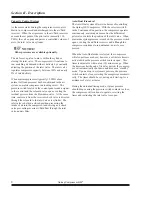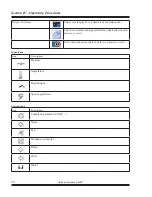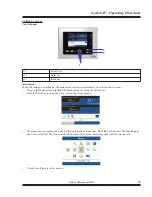
Section III - Installation
14
Quincy Compressor-QSI
®
having to be sprung or twisted into position. Adequate
expansion loops or bends should be installed to prevent
undue stress at the compressor resulting from the changes
between hot and cold conditions. Pipe supports should be
mounted independently of the compressor and anchored,
as necessary, to limit vibration and prevent expansion
strains. Piping should never be of smaller size than the
connection on the compressor unit.
Relief Valves
Pressure relief valves are sized to protect the system.
Never change the pressure setting or tamper with the
valve. Only the relief valve manufacturer or an approved
representative is qualified to make such a change.
DANGER!
Relief valves are to protect system integrity in ac-
cordance with ANSI/ASME B19 safety standards.
Failure to provide properly sized relief valves will
result in death or serious injury.
Relief valves are to be placed ahead of any potential
blockage point that includes, but is not limited to, such
components as shut-off valves, heat exchangers and
discharge silencers. Ideally, the relief valve should be
threaded directly into the pressure point it is sensing, not
connected with tubing or pipe and pointed away from any
personnel. Always direct discharge from relief valves to
a safe area away from personnel.
Figure 3-1. Relief Valve
Electrical
Before installation, the electrical supply should be
checked for adequate wire size and capacity. During
installation, a suitable fused disconnect switch or circuit
breaker should be provided. Any unreasonable voltage
unbalance (5%) between the legs must be eliminated and
any low voltage corrected to prevent excessive current
draw. The installation, electric motor, wiring and all
electrical controls must be in accordance with National
Electric Code, and all state and local codes. A quali
-
fied electrician should perform all electrical work.
Air
compressors must be grounded in accordance with
applicable codes.
See control panel for the proper wir-
ing diagram.
Quincy would like to emphasize the importance of
providing adequate grounding for air compressors. The
common practice of grounding units to building structural
steel may not actually provide adequate grounding pro-
tection, as paint and corrosion build-up may exist.
CAUTION!
NEMA electrical enclosures and components
must be appropriate to the area in which they
are installed.
Pneumatic Circuit Breakers or Velocity Fuses
The Occupational Safety and Health Act, Section
1926.303 Paragraph 7 published in Code of Federal
Regulations 29 CFR 1920.1 (revised 07/01/1982), states
“all hoses exceeding 1/2” inside diameter shall have a
safety device at the source of supply or branch line to re-
duce pressure in case of a hose failure.” These pneumatic
safety devices are designed to prevent hoses from whip-
ping, which could result in a serious or fatal accident.
Guards
All mechanical action or motion is hazardous in vary-
ing degrees and needs to be guarded. Guarding shall
comply with OSHA Safety and Health Standards 29 CFR
1910.219 in OSHA manual 2206 (revised 11/07/1978)
and any state or local codes.
Summary of Contents for QSI Series
Page 2: ......
Page 7: ...Section I General Quincy Compressor QSI 5 MODEL IDENTIFICATION...
Page 62: ...Section IV Operating Procedures 60 Quincy Compressor QSI 1 Week Timer 2 Remaining Running Time...
Page 79: ...Section IV Operating Procedures Quincy Compressor QSI 77...
















































